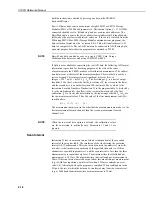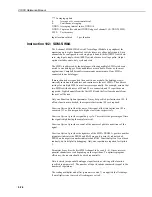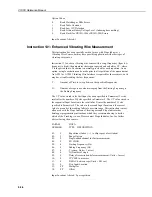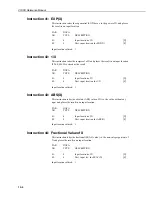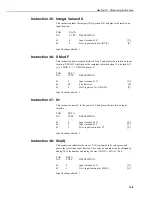
Section 9. Input/Output Instructions
9-31
port number (1-8) attached to the SDI-12 data line. The CR10X responds with
‘entering SDI-12’. Any SDI-12 command preceded with the address and followed
with an exclamation mark ‘!’ can now be entered. For example, entering ‘
0I!
’ at
the ‘<’ prompt would request identification from an SDI-12 sensor with an
address of 0.
The ‘SDI-12’ prompt does not appear until the CR10X has finished executing all
its program tables. Once it is in transparent mode, the CR10X will not execute the
program tables.
Transparent mode ends and the ‘*’ prompt is returned when an invalid SDI-12
command (e.g. a blank line) is entered, if the SDI-12 sensor does not respond
within the time-out period following a valid command (approximately 1/3
second), or if the user does not enter a command before the mode times out
(approximately 35 seconds). Security must be unlocked to level 2 before the
transparent mode can be used.
Instruction 106 — SDI-12 Sensor
Instruction 106 allows a CR10X to be used as an SDI-12 sensor, i.e. the CR10X
can make measurements and transfer data using SDI-12 commands in response to
another SDI-12 recorder.
Instruction 106 supports the standard SDI-12 commands as listed in the
description of parameter 2 for Instruction 105.
The SDI-12 data line is attached to control port 8 and Instruction 106 must be the
first instruction in Subroutine 98 located in Table 3. An SDI-12 recorder
addresses the SDI-12 ‘sensor CR10X’ by sending a Break followed by the
sensor’s address. The ‘sensor CR10X’ calls subroutine 98 whenever it detects
activity on the SDI-12 data line attached to port 8, but if the Break and the
specified address are not received by Instruction 106, the remainder of the
subroutine is not executed.
There are two programming techniques for obtaining measurement values to be
transferred by the ‘sensor CR10X’ using Instruction 106. The first technique
makes the requested measurements ‘on demand’ in response to the recorder’s
request. The measurement instructions are located in Subroutine 98 and are
executed only when the SDI-12 recorder requests measurements. This technique
is preferred when measurements are to be made at the recorder’s command.
The second technique transfers measurement values previously obtained by
instructions in Table 1 or Table 2. Subroutine 98 contains only Instructions 106
(SDI-12 Sensor) and 95 (End). When the recorder requests measurements, values
already in the specified Input Locations are used. The advantage of this technique
is that the ‘sensor CR10X’ can be making and storing measurements independent
of the SDI-12 recorder. The data is also returned slightly faster since the ‘sensor
CR10X’ does not make measurements when the recorder requests data, but rather
uses measurements made at the last regular table execution.
These two techniques can be combined, allowing the ‘sensor CR10X’ to function
as an SDI-12 sensor and to make independent measurements.


